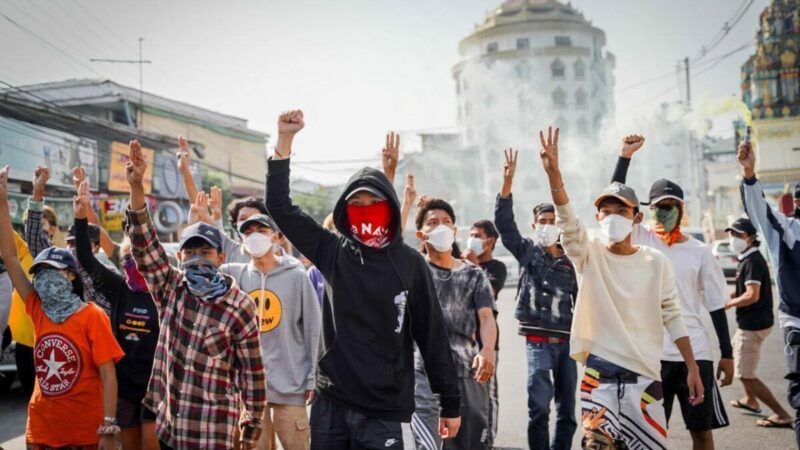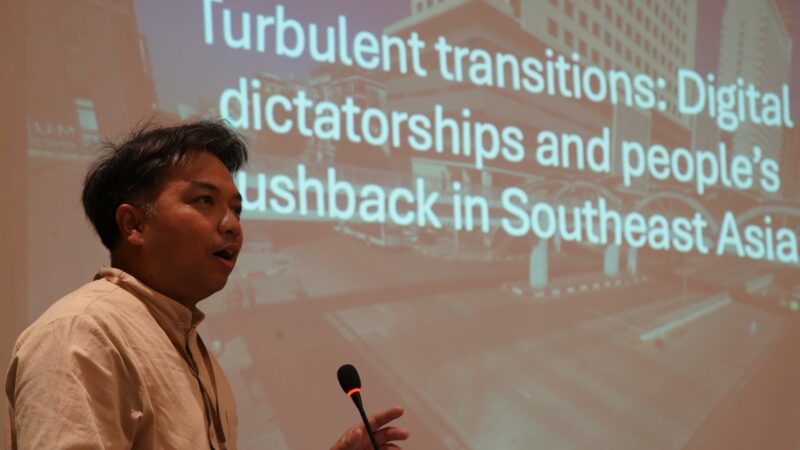
Youth activists stage a flash mob in protest against the continuing junta rule. Photo from Yangon Revolution Force, used with permission.
The past decade saw the rise of varying shades of undemocratic regimes in Southeast Asia, reflected in the 2014 coup in Thailand, the election of Rodrigo Duterte in 2016 in the Philippines, and the return of military dictatorship in 2021 in Myanmar. On the other hand, the intensified repression was countered by people’s resistance energized by young activists who combined online and offline tactics to push back against tyranny and digital authoritarianism.
If absolute censorship marked the junta rule in both Thailand and Myanmar, free speech was curtailed through arbitrary and aggressive implementation of repressive laws in the rest of the region. Outdated and colonial-era regulations (Malaysia’s Sedition Act and defamation in Indonesia) were enforced to criminalize dissent. After the passage of anti-cybercrime bills, authorities often cited the internet-enabled spread of disinformation to justify the hasty approval of anti-fake news legislation like Singapore’s Protection from Online Falsehoods and Manipulation Act.
The pandemic allowed governments to impose emergency decrees that led to the banning of mass assemblies. Cities were placed under militarized lockdown orders. Mandatory apps for the distribution of aid and vaccines normalized surveillance and undermined the privacy rights of citizens. Governments beleaguered by legitimacy issues weaponized existing media laws, and introduced new measures intended to stifle legitimate criticism under the guise of protecting public health and safety. This was evident in Thailand and Cambodia, which revived the use of Lese Majeste (anti-Royal Insult Law) against critics, including citizens who were merely complaining about the government’s pandemic response.
The end of the pandemic was not followed by the reversal of draconian measures. Instead, authorities doubled down on the use of repressive laws to regulate online content strictly and restrict protests in public places. For authoritarian regimes like Vietnam, the post-pandemic “state of emergency” boosted the police power of the state as it targeted critical bloggers, scholars, and NGO leaders. In Cambodia, the Hun Sen government’s heavy-handed approach in dealing with the health crisis was also applied in forcing the disbandment of opposition parties accused of colluding with foreign forces.
Read more: What will it take to combat digital authoritarianism in Southeast Asia?
Despite these challenges, citizen movements emerged to defy tyranny and reclaim civic space under the harsh control of intolerant regimes. For example, the brutal reign of military dictatorships in Myanmar and Thailand only emboldened citizens to be more daring and creative in their resistance.
Myanmar’s “Spring Revolution” challenged the junta since day one of the coup. It involved citizens initiating the civil disobedience movement which linked guerrilla protests in urban centers and militant struggles in ethnic communities. Media censorship prompted independent media outlets to rely on citizen journalists for frontline reporting while operations shifted to safe territories in remote regions and even abroad. Interestingly, an example of the effective use of social media was the “silent strikes,” which enjoined residents to protest by remaining in their homes without the risk of being arrested by junta forces. This was coordinated through messaging platforms while images of empty streets and town centers were displayed on various social media channels.
Read more: Myanmar's Spring Revolution and Civil Disobedience Movement
In Thailand, students and youth activists seized the initiative in the pro-democracy movement with their radical determination to restore civilian rule. The victory of opposition parties in 2023 was largely attributed to the efforts of young protesters in sustaining the clamor for the return of open elections and democratic rule. This was achieved by organizing street protests and amplifying the calls for reform through online engagement. The military-backed government actively suppressed these critical voices, but the youth-led resistance didn’t back down.
Read more: Why are young people protesting in Thailand?

The author speaking in a peace conference in February in Cambodia. Photo by Karlos Manlupig, used with permission.
During the pandemic, the internet became a tool of repression in the hands of paranoid and inept regimes. But it was wielded as a force for good by citizens extending aid to neighbors in need of urgent aid. For instance, the setting up of a small community pantry in Manila inspired internet users to replicate the initiative in their own barangays (villages). Social media became a “loudspeaker” informing the public reeling from extended lockdowns about the locations of these rolling stores offering free food and basic necessities. It was a simple but politically powerful message exposing the failure of the government to deliver services needed by the quarantined population.
This was not just limited to the Philippines. In Indonesia, the hashtag #wargabantuwarga (citizens helping citizens) captured the role of online interventions in life-saving situations. In Malaysia, the White Flag (Bendera Putih) movement encouraged the community to provide assistance to households where a white flag or banner was displayed on windows, gates, and doors. These initiatives ignited volunteerism in the community and, at the same time, refuted the scaremongering of despots about the proliferation of content that allegedly harms social harmony and national security.
Perhaps the best example of a region-wide and cross-region collaboration is the Milk Tea Alliance, an informal network of young activists fighting for democracy and showing solidarity with pro-democracy movements across Asia. From Myanmar and Thailand to Taiwan and Hong Kong, this movement generated trends, memes, and political actions that crossed borders and heralded the broader unity against digital tyranny.
Read more: Milk Tea Alliance and the fight for democracy
It has been a tumultuous decade for Southeast Asia. War and conflict continue to disrupt the region while citizens assert the right to live in societies with real freedom, peace, justice, and democracy. As internet use became more widespread, it was also turned into an essential weapon of citizen movements speaking truth to power. In response, governments clamped down on the internet, but they largely failed to deter protests. Internet shutdowns became more frequent, but in the end, they only antagonized the local population. Indeed, repression continues in many parts of the region, but so does the people’s resistance.








